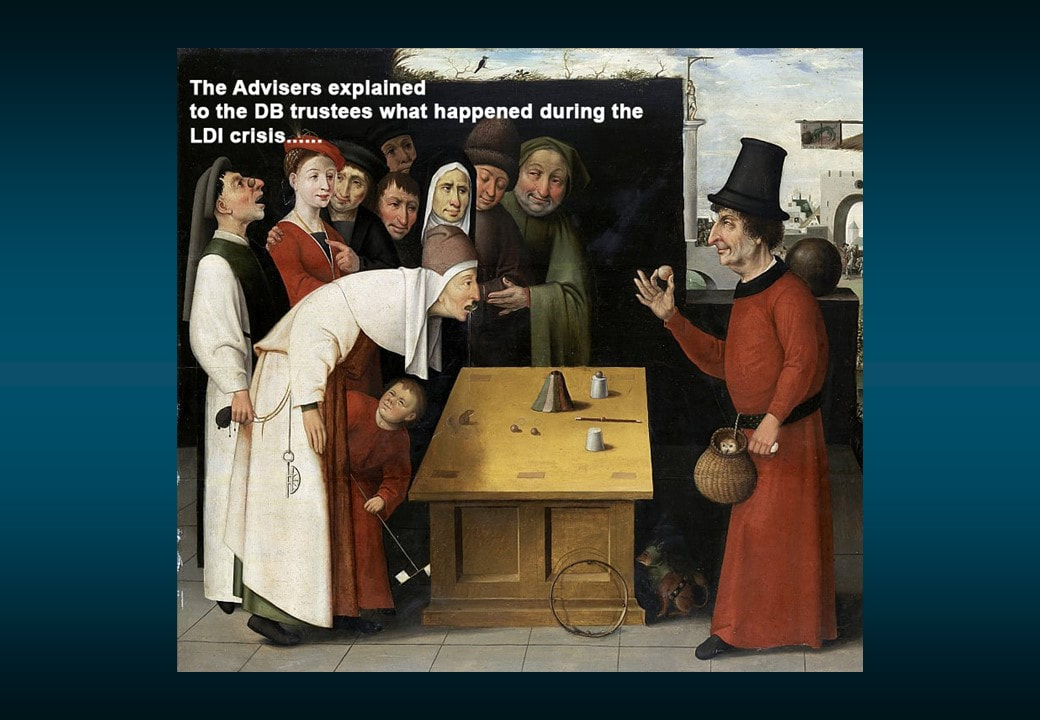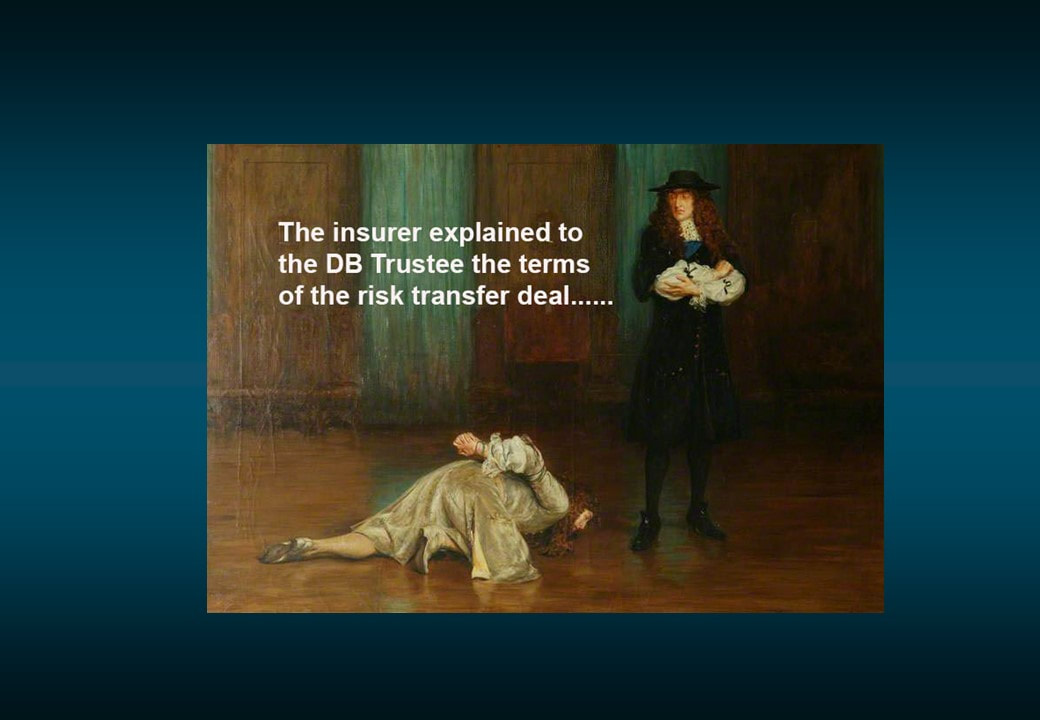|
Value for Sponsors and Past and Present Employees in Getting Stuck In What to do with surpluses in old Defined Benefit pension schemes? It’s a question Government has put to the pension industry and sponsoring companies in a formal Consultation ending on 19th April. There is a positive answer. Use them to increase pensions and improve pension provision massively for today’s employees at a reducing cost to the employer. There is £300 billion at stake.
The summary is “Run On 4 Good” – keep going steadily on, aiming for stable long-term returns. Then, as excessive optimism about life expectancy becomes ever clearer, the scheme’s trustees will see the scheme has more money than it will ever need. What a great chance to invest in what Government sees as productive assets – like infrastructure. Then set about addressing, with the sponsor, intergenerational unfairness in pension provision and raising pensions- all in a new deal. And it will happen. Provided there is not a public policy error after the Consultation which allows sponsors to syphon large sums back to their Global HQ and still hand pension schemes over to life insurers. Sponsors are big winners. Companies and today’s employees can benefit from DB surpluses paying more and more of their pension contributions as well as discretionary improvements being made to pensions in payment. For scheme members the ultra successful Pension Protection Fund with its £12bn surplus is there covering more and more of remaining payments even in the unlikely event that the sponsor disappeared. And if a scheme can afford a buyout, it can afford not to. Better to ensure the sponsor’s Board see the scheme as a worked example of ESG policy in practice, aligned with its people and environmental priorities. It is a corporate wealth fund. So the case for buyouts has collapsed with surpluses – unless you are part of the cosy, well-heeled actuarial consultancy / life insurer pension axis. A parliamentary Select Committee reported in April concluding too much regulatory caution had largely killed off good pensions. We should not be here. But we are. The art in pensions is to take your time. Exercise discretion. Don’t over commit. But past and present employees should expect more. The pension industry remains obsessed with ‘Endgames’. But it’s not the End and it’s not a Game. Plenty to go for. The downside is remote and falling; the upside can be significant and immediate using existing trustee powers when there is sponsor backing. Members can be impactful. When pensions were just about trustees protecting past benefits, member engagement was modest. And now? Just let employers and trustees know you are keen to hear about their new opportunities to exercise discretion. The Government is rethinking its approach. There is also value for members in getting stuck in. Learn more about Run On 4 Good Final salary pension scheme members are widely considered in the pension industry and beyond as “lucky bastards” from the baby boomers generation. Scheme trustees, sponsors and regulators have been grimly determined to “get rid ASAP” of a legacy problem. Shuffle responsibility off to life insurers at almost any price. The consequence has been life insurers and their support crew are very prosperous. Discretionary improvements for members? You must be bloody joking.
Now in spite of actuaries and investment consultants squandering resources through on indexed linked gilts and leveraged LDI, most schemes have more money than they apparently need. That is because life expectancy has proved overstated; interest rate increases have reduced liabilities (the way actuaries calculate them) and inflation has reduced the real value of pensions in payment. So not living so long and having less buying power than expected is not quite so fortunate. But who cares? Be grateful for what you have got. Boomer. Members, it's time to revolt. Resources are there and the pension industry is in search of options for the money other than bulk transfers. Ask for more. Trustees do sometimes ask for discretionary increases - but usually on a “going through the motions” basis knowing the sponsor has to agree and they won't. Don’t let that happen. What members should now do is align with today's workers in a campaign to ensure that pension funds and surpluses arising are directed, as originally intended by the Trust, to the benefit of past and present employees. It’s possible. Circumstances post the LDI crisis have changed. HM Treasury want schemes to run on longer and invest in productive assets. DWP’s current consultation on DB schemes asks what should become of surpluses. Straight forward. Within existing legalisation and tax practice there can be “discretionary step ups” in current pensions paid. This can become common practice. As part of a package, proposals can be introduced for comparable sums to be added to the DC pots of current employees in new tiers with DB scheme. Intergenerational fairness addressed. What’s needed is to run on long term with a stable, well diversified assets portfolio and with a sponsor provided third party sum as a guarantee. And don’t forget the well financed Pension Protection Fund covering ever more of your pension should the sponsor fail. It’s in all stakeholders’ interests. Not luck. Just good trustee and sponsor judgement is needed. Time for members to expect not less but more. And now. We suggest writing to the Chair of the scheme trustees and the Chair of the sponsor. Once they realise there are stakeholders taking an active and informed interest, expect policy changes to follow. Suggested letters to Chairs can be found on the website See Letters To Chairs New Government Attitude : Bellwether question : Run On 4 Good
Make 2% per annum of assets available to benefit all stakeholders Government led by HM Treasury has a new mindset on pensions. Out goes “reckless prudence” and “the safest graveyard” in favour of productive assets and intergenerational fairness. Pension consultants and trustees addicted to risk transfers to life insurers are starting to see virtue in “run on”. Shareholders, bankers, City Institutions, ESG/ financial rating agencies and past and present employees should all ask this bellwether question which is so telling about trustees and sponsor. “What is the DB scheme’s long term investment return target?” Answer A: Stable at over gilts plus 1.5%
Answer B: Tapering down towards gilts flat
Respond positively. Trustees and sponsor can get stuck in so all stakeholders benefit. Rewrite the Statement of Investment Principles to add ‘Run On 4 Good’ into the plan. Avoid falling into the overheated Risk Transfer market. Read more about the Government / Regulator led approach and the 2% p.a of assets upside opportunity. |
Archives
April 2024
|
C-Suite Pension Strategies Ltd
80 Coleman Street, London EC2R 5BJ
Registered in England and Wales
Company No. 09974973
80 Coleman Street, London EC2R 5BJ
Registered in England and Wales
Company No. 09974973









 RSS Feed
RSS Feed